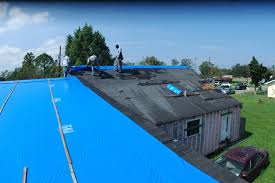Flatbed drivers not only have the responsibility of safely transporting valuable and bulky goods over very long distances, which can be extremely hazardous in winter but they too need to put on the tarpaulin in such a way that the goods remain secured against movement and protected from the inclement weather. Some important safety tips that flatbed drives should follow, especially during the winter:
Warm the Tarpaulin Before Using It
A large flatbed tarp can be quite difficult to handle, especially when the conditions are freezing and the tarp is ice-cold. When the temperature is low, the tarp material tends to become stiff and brittle and develop cracks when the tarp is being stretched. It can be a very good idea to stow the tarp in the driver’s cabin for the duration of your drive to the pickup destination. The warmth of the heater inside the cab will thaw the tarp and warm it up sufficiently to make it easier to handle. Ideally, after you arrive at your destination, you should remove the tarp and keep in on the floor of a warehouse while the unloading and the paperwork are being completed. This will warm up the tarp and you will be able to fold it up easily without causing it to crack.
Don’t Make Haste Tarping Your Flatbed
It is important to be careful and methodical when installing the 20×20 tarp on the flatbed truck, even if the freezing conditions make you want to hurry up the process. However, speeding up the process can not only cause damage to the tarp but also result in you becoming injured. Remember, the cold weather makes the tarp more prone to developing tears while you are putting it on and even a small tear can very easily spread right across the tarp when buffeted by cold winds during the journey. Also, while rushing to secure the tarp, you may make a mistake and not tighten a strap adequately. The loose strap or the ballooning tarp may injure you or even cause the tarp to come loose and blow away during the journey. Taking frequent breaks to warm up can help you to be more mindful and prevent accidents due to faulty tarp installation. According to https://ohsonline.com, keeping a proper watch on the tarp movement is essential for preventing accidents.
Wear Gloves to Protect Your Hands
Getting a tight grip on the tarp or a strap can be difficult with bare hands under freezing conditions. Using a pair of rubber-tipped gloves over your leather gloves is a very good way of keeping your fingers safe from getting injured from an icy cold tarp. Wearing latex gloves under your work gloves can also keep your hands protected from getting wet and cold that may even lead to frostbite. If you can don woolen gloves and then put on latex gloves, your hands will also stay warm and dry.
Conclusion
Other things to keep in mind to prevent injury while putting on a flatbed tarp in winter are checking the D-Rings and grommets for wear and tear and watching out for the occurrence of voids where cold water can accumulate on the tarp and damage it due to ice formation.
